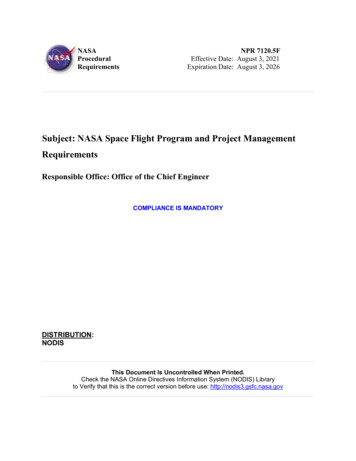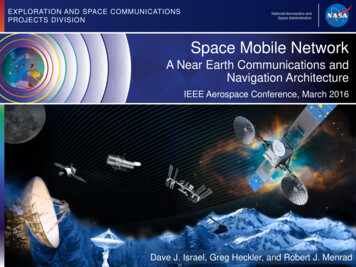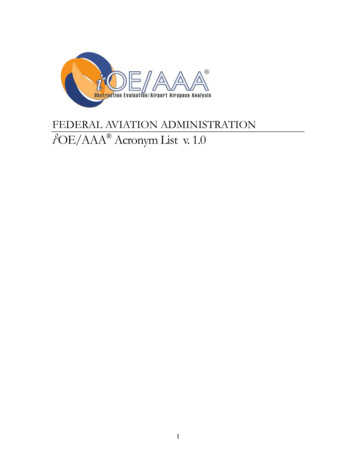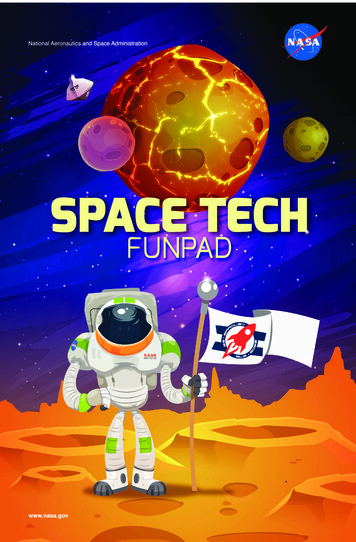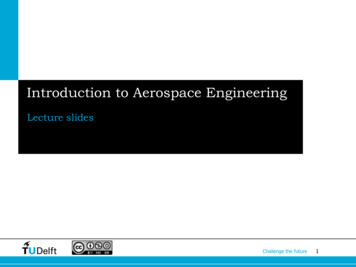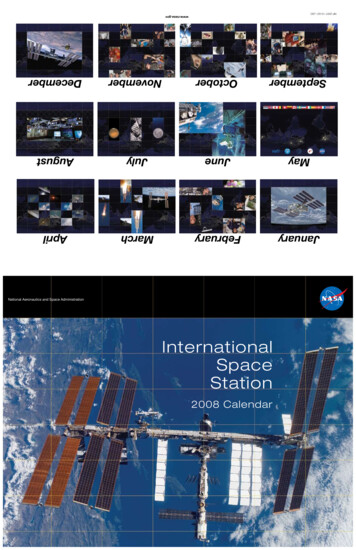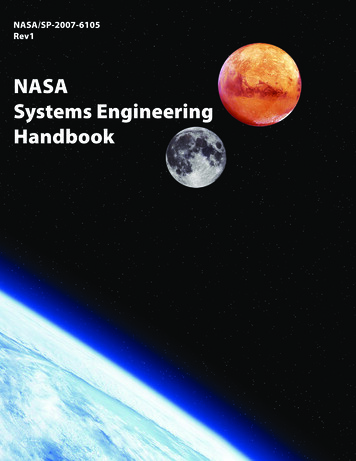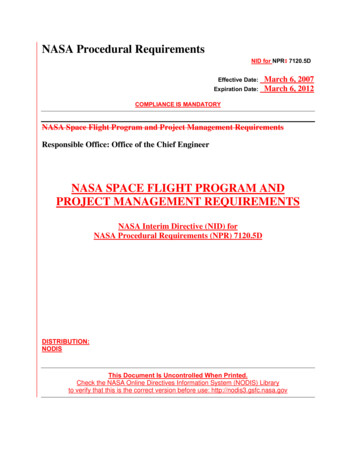
Transcription
NASA Procedural RequirementsNID for NPR: 7120.5DEffective Date:Expiration Date:March 6, 2007March 6, 2012COMPLIANCE IS MANDATORYNASA Space Flight Program and Project Management RequirementsResponsible Office: Office of the Chief EngineerNASA SPACE FLIGHT PROGRAM ANDPROJECT MANAGEMENT REQUIREMENTSNASA Interim Directive (NID) forNASA Procedural Requirements (NPR) 7120.5DDISTRIBUTION:NODISThis Document Is Uncontrolled When Printed.Check the NASA Online Directives Information System (NODIS) Libraryto verify that this is the correct version before use: http://nodis3.gsfc.nasa.gov
TABLE OF CONTENTSPrefaceP.1 PURPOSEP.2 APPLICABILITYP.3 AUTHORITYP.4 APPLICABLE DOCUMENTSP.5 MEASUREMENT/VERIFICATIONP.6 CANCELLATIONChapter 1. Introduction1.1 Background1.2 Overview of Management Process1.3 Document StructureChapter 2. NASA Life Cycles for Space Flight Programs and Projects2.1 Programs and Projects2.2 Program Life Cycle2.3 Project Life Cycle2.4 Program and Project Oversight and Approval2.5 Program and Project ReviewsChapter 3. Program and Project Management Roles and Responsibilities3.1 Overview of Roles and Responsibilities3.2 Specific Roles and Responsibilities3.3 Process for Handling Dissenting Opinions3.4 Technical Authority3.5 Center Reimbursable Space Flight Work3.6 Principles Related to Tailoring Requirements
Chapter 4. Program and Project Requirements by Phase4.1 Programs—Formulation Phase4.2 Programs—Implementation Phase4.3 Projects—Pre-Phase A4.4 Projects—Phase A4.5 Projects—Phase B4.6 Projects—Phase C4.7 Projects—Phase D4.8 Projects—Phase E4.9 Projects—Phase FAPPENDIX A DefinitionsAPPENDIX B AcronymsAPPENDIX C Formulation Authorization Document TemplateC.1Program FAD Title PageC.2Project FAD Title PageC.3Program/Project FAD TemplateAPPENDIX D Program Commitment Agreement TemplateD.1PCA Title PageD.2PCA TemplateAPPENDIX E Program Plan TemplateE.1Template InstructionsE.2Program Plan Title PageE.3Program Plan TemplateAPPENDIX F Project Plan TemplateF.1Template InstructionsF.2Project Plan Title Page
F.3Project Plan TemplateAPPENDIX G Space Flight Project Work Breakdown StructureAPPENDIX H References
LIST OF TABLESTable 1-1 Programmatic Requirements HierarchyTable 2-1 Project Categorization GuidelinesTable 2-2 Relationship Between Programs/Projects and PMCsTable 2-3 Major Program/Project Life Cycle Reviews Not Conducted by the SRBTable 2-4 NASA Convening Authorities for Standing Review BoardTable 2-5 SRB StructureTable 2-6 Space Flight Program ReviewsTable 2-7 Space Flight Project ReviewsTable 3-1 Roles and Responsibilities Relationships MatrixTable 3-2 Minimum Attributes for Requests for Requirement ReliefTable 3-3 Tracking DataTable 3-4 Waiver or Deviation Approval for NPR 7120.5 RequirementsTable 4-1 Program Gate Products Maturity MatrixTable 4-2 Program Plan Control Plan Maturity MatrixTable 4-3 Project Gate Products Maturity MatrixTable 4-4 Project Plan Control Plan Maturity MatrixTable D-1 Sample Program Commitment Agreement Activities Log
LIST OF FIGURESFigure 1-1 Separation of Programmatic and Institutional AuthorityFigure 1-2 Institutional Requirements Flow DownFigure 1-3 NASA Core ValuesFigure 2-1 Programmatic Authority Organizational HierarchyFigure 2-2 Space Flight Program and Project Management Process OverviewFigure 2-3 The NASA Program Life CycleFigure 2-4 The NASA Project Life CycleFigure 2-5 Program/Project Independent Life Cycle Review ProcessFigure C-1 Program Formulation Authorization Document Title PageFigure C-2 Project Formulation Authorization Document Title PageFigure D-1 Program Commitment Agreement Title PageFigure E-1 Program Plan Title PageFigure F-1 Project Plan Title PageFigure G-1 Standard Level 2 WBS Elements for Space Flight Projects
PrefaceP.1 PURPOSEThis document establishes the requirements by which NASA will formulate andimplement space flight programs and projects, consistent with the governance modelcontained in the NASA Policy Directive (NPD) 1000.0, NASA Governance and StrategicManagement and Governance Handbook.(NPD 1000.0).P.2 APPLICABILITYa. This NASA Interim Directive (NID) for NASA Procedural Requirement (NPR)7120.5D is applicable applies to NASA Headquarters and NASA Centers,including Component Facilities and Technicalthe Jet Propulsion Laboratory, andService Support Centers. This language applies to JPL, other contractors, grantrecipients, or parties to agreements only/service providers to the extent specifiedor referenced in the appropriatetheir contracts, grants, or agreements with NASA.b. This NID NPR applies to all current and future NASA space flight programs andprojects (including spacecraft, launch vehicles, instruments developed for spaceflight programs and projects, research and technology developments funded byand to be incorporated into space flight programs and projects, critical technicalfacilities specifically developed or significantly modified for space flight systems,and ground systems that are in direct support of space flight operations). This NIDNPR also applies to reimbursable space flight programs/projects performed fornon-NASA sponsors. For existing programs and projects, the requirements of thisdocument are applicable to the program/project’s extant phase as of the effectivedate of this NID NPR and to phases yet to be completed.c. This NID NPR can be applied to other NASA investments at the discretion of theresponsiblecognizant manager or the NASA Associate Administrator.P.3 AUTHORITYa. 42 U.S.C. 2473(c) (1), Section 203(c) (1) of the National Aeronautics and SpaceAct of 1958, as amended.b. NPD 1000.0, NASA Governance and Strategic Management Handbook.c. NPD 1000.3, The NASA Organization.d. NPD 1000.5, Policy for NASA Acquisitione. b.NPD 7120.4, NASA Engineering and Program/Project ManagementPolicy.
P.4 APPLICABLE DOCUMENTSa. NPD 1001.0, NASA Strategic Planb. NPD 8700.1, NASA Policy for Safety and Mission Successc. NPD 8900.5, NASA Health and Medical Policy for Human Space Explorationd. NPR 7120.6, Lessons Learned Processe. NPR 7120.7, NASA Information Technology and Institutional InfrastructureProgram and Project Management Requirementsf. NPR 7120.8, NASA Research and Technology Program and Project ManagementRequirementsg. NPR 8000.4, Agency Risk Management Procedural Requirementsh. NPR 8705.5, Probabilistic Risk Assessment (PRA) Procedures for NASAPrograms and Projectsi. NPR 9420.1, Budget Formulationj. NPR 9470.1, Budget Executiona. NPD 1000.0, Strategic Management and Governance Handbook.b. NPD 1000.3, The NASA Organization.c. NPD 7120.4, Program/Project Management.P.5 MEASUREMENT/VERIFICATIONCompliance with this document is verified by submission to responsiblecognizant NASAofficials, at key decision points, of the gate products identified in this document and byinternal and external controls. Internal controls include audit, review, and assessmentprocesses defined in NPD 1200.1, NASA Internal Control. External controls may includeexternal audits and reporting requirements.P.6 CANCELLATIONNone.ii
Mike RyschkewitschNPR 7120.5C, NASA Program and Project Management Processes and Requirements,dated March, 2005, is cancelled for space flight programs and projects (as defined in P.2),but remains in effect for all other programs and projects.The NASA Interim Directive (NM 7120-40) to NPR 7120.5C, NASA Program andProject Management Processes and Requirements, dated March 6, 2006, is cancelled forspace flight programs and projects (as defined in P.2), but remains in effect for all otherprograms and projects./s/ Christopher ScoleseNASA Chief EngineerDISTRIBUTION:NODISiii
CHAPTER 1. Introduction1.1Background1.1.1 NASA space flight programs and projects develop and operate a wide variety ofspacecraft, launch vehicles, in-space facilities, communications networks, instruments,and supporting ground systems.1 This document establishes a standard of uniformity forthe process by which NASA will formulate and implement space flight programs andprojects consistent with the governance model contained inNPD 1000.0, NASAGovernance and Strategic Management and Governance Handbook. The governancemodel provides an organizational structure that emphasizes mission success by takingadvantage of different perspectives that different organizational elements bringNASAspace flight programs and projects develop and operate a wide variety of spacecraft,launch vehicles, in-space facilities, communications networks, instruments, andsupporting ground systems.2 This document is intended to issues. The organizationalseparation of the Mission Directorates and their respective establish a standard ofuniformity in the management of such programs and projects (Programmatic Authorities)and the Headquarters Mission Support Offices, the Center organizations that are alignedwith these offices, and the Center Directors (Institutional Authorities) is the cornerstoneof this organizational structure and NASA’s system of checks and balances. This systemis built on the principle that “no one gets to grade his or her own work.”.The separation of authorities is illustrated in Figure 1-.1.Office of AdministratorProgrammaticAuthorityInstitutional AuthorityEngineeringMDETAProgramSafety onSupportOfficesCenterDirectorsProjectTA Technical Authority1NASA space flight programs and projects often must mature technologies to meet mission goals. Theseenabling and/or enhancing technologies are also covered by this NPR.4
Figure 1-1 Separation of Programmatic and Institutional Authority1.1.2 Programmatic Authority resides with the Mission Directorates and their respectiveprograms and projects. It is largely described in sections 3.1 and 3.2 by the roles andresponsibilities of the NASA Associate Administrator (AA), Mission DirectorateAssociate Administrators (MDAAs), and program and project managers.1.1.3 The Institutional Authority encompasses all those organizations not in theProgrammatic Authority. Engineering, Safety and Mission Assurance, and Health andMedical organizations are a unique segment of the Institutional Authority. They supportprograms and projects in two ways:a) They provide technical personnel and support and oversee the technical work ofpersonnel who provide the technical expertise to accomplish the program orproject mission.b) They provide Technical Authorities, who independently oversee programs andprojects. These individuals have a formally delegated Technical Authority roletraceable to the Administrator and are funded independent of programs andprojects. The Technical Authorities are described in Section 3.4.1.1.4 Well trained and experienced program and project managers are essential to thesuccessful accomplishment of NASA’s overall mission as well as to the success ofindividual programs and projects. In recognition of this, and in compliance with OMBpromulgated Federal acquisition program/project management certification requirements,NASA has instituted an Agency-wide career development framework and program tocertify a cadre of career personnel to meet the Agency’s current and future demands forprogram and project managers. The development framework and certification arecontained in the NASA Project Management Competency Model and the FederalAcquisition Certification for Program/Project Managers—Center ImplementationGuidelines. Certification is required for individuals who manage programs or projectswith a life cycle cost greater than 250 million.1.1.5 1.1.2Central to the program and projectbuilding this cohesive managementprocess areis the introduction of NASA space flight program and project life cycles, andthe identification of the Key Decision Points (KDPs) within these life cycles. Thisdocument also outlines program/project decision processes and summarizes the roles andresponsibilities of key personnel involved in responsible for NASA program and projectmanagement: the Agency Program Management Council (PMC), the MissionDirectorates, the Centers,, 3 program managers, and project managers. It further identifiesand summarizes the technical authority process as it applies to space flight program and3The term “Center” here and throughout this document is meant to include NASA Component Facilities,Technical and Service Support Centers (per NPD 1000.3), and the Jet Propulsion Laboratory (JPL).5
project management,4 and codifies the top-level management requirements for safe andsuccessful program/project formulation and implementation.1.1.6 1.1.3This document distinguishes between programmatic requirements, on theone hand, and institutionalmanagement process requirements, on the other. Bothcategories of requirements must ultimately be satisfied in program and projectformulation and implementation. Programmatic requirements are the responsibility ofthe Programmatic Authorities and focus on the space flight products to be developed anddelivered, and specifically relate to the goals and objectives of a particular NASAprogram or project. These requirements flow down from the Agency’s strategic planningprocess. Table 1-1 shows this flow -down from Agency needs, goals, and objectives (,described in the NASA Strategic Plan), to programs and projects.4The establishment of a technical authority process represents a direct response to the Columbia AccidentInvestigation Board (CAIB) recommendations— specifically, CAIB recommendation R7.5-1—andrepresents a critical shift in NASA’s program and project management strategy relating to safety.6
Table 1-1 Programmatic Requirements ocumentContentApproverOriginatorNPD 1000.0,Administrator SupportOrganizationsNASAGovernanceand StrategicManagementHandbook,NASAStrategic Plan,and StrategicPlanningGuidanceAgency strategic direction based onhigher-level directionAgencyStructure, relationships, principlesRequirements governing design and evolution of crossAgency Mission Directorate systemslinked in accomplishing Agency needs,goals, and trator Host MDAAwith Inputsfrom OtherAffectedMDAAsMissionHigh-level requirements levied on aDirectorateprogram to carry out strategic andRequirements architectural direction includingprogrammatic direction for initiatingspecific amDetailed requirements levied on aProgram PlanRequirements program to implement the PCA and highlevel programmatic requirementsallocated from the program to its projectsMDAAProgramManagerProjectDetailed requirements levied on a project Project PlanRequirements to implement the Program Plan and flowdown programmatic requirementsallocated from the program to the projectProgramManagerProjectManagerSystemDetailed requirements allocated from the SystemProjectRequirements project to the next lower level of theRequirements ManagerprojectDocumentationResponsibleSystem LeadMDAA Mission Directorate Associate Administrator; AA NASA Associate Administrator1.1.7 1.1.4Management process requirements Institutional requirements are theresponsibility of the Institutional Authorities. They focus on how NASA does businessand are independent of any particular program or project. These requirements are issuedby NASA Headquarters (, including the Office of the Administrator, MissionDirectorates, and Mission Support Offices), and by Center organizations. InstitutionalManagement process requirements may respond to Federal statute, regulation, treaty, orexecutive order. They are normally documented in the following:a. NASA Policy Directives (NPDsDirective (NPD) – NPDs are Agency policystatements that describe what is required by NASA management to achieveNASA’sNASA's vision, mission, and external mandates and describe who isresponsible for carrying out those requirements.7
b. NASA Procedural Requirements (NPRs) – NPRs provide Agency-mandatoryinstructions and requirements to implement NASA policy as delineated in anassociated NPD.c. NASA Standards – NASA Standards are formal documents that establish a norm,requirement, or basis for comparison, a reference point to measure or evaluateagainst. A technical standard, for example, establishes uniform engineering ortechnical criteria, methods, processes, and practices.d. c.Center Policy Directives (CPDsDirective (CPD) – CPDs define Centerspecific policy requirements and responsibilities that apply only to the issuingCenter and operations performed by NASA personnel at that Center (and mustcomply with requirements delineated in associated NPDs and NPRs).e. d.Center Procedural Requirements (CPRs) – CPRs establish Center-specificprocedural requirements and responsibilities to implement the policies andprocedural requirements defined in related NPDs, NPRs, or CPDs. CPRs applyonly to the issuing Center and operations performed by NASA personnel at thatCenter.f. e.Mission Directorate or Programmatic Requirements – Mission Directorateor programmatic Programmatic requirements contained in Mission Directorate orprogram documentation that apply to activities, products, or services supportingprogram and project office needs, which could extend across multiple personnellocated at NASA Centers.1.1.8 1.1.5This NID for revision of NPR 7120.5 is part of a realignment of governingdocuments within NASA designed to increase accountability and general clarity in theflow -down of both programmatic and institutionalmanagement process requirements.Figure 1-21 shows flow down the document hierarchy from NPD 1000.0 throughprogram and project plans. The figure identifies the fivefour types ofinstitutionalmanagement process requirements that flow down to these plans:engineering, program/project management, safety and mission assurance, health andmedical (SMA), and Mission Support Office (MSO) functional requirements. These termsare defined in Appendix A.8
NPD 1000.0NPD 1000.3NPD 1000.5NPD 7120.4Engineeringand RelatedDirectivesNPD 8700.1Program and ProjectManagementDirectivesEngineering SMADirectivesSafety and MissionAssuranceRequirementsMission DirectorateProgrammaticRequirementsNPD 8900.5OCHMODirectivesHealth and MedicalRequirementsCenter Engineeringand ManagementPolicies andPracticesProgram andProject PlansFigure 1-2 Program/Project ManagementInstitutional Requirements Flow Down1.2 Overview of Management Process1.2.1 Although this document emphasizes program and project management based onlife cycles, KDPs, and evolving products during each life -cycle phase are emphasized inthis document, these are embedded in NASA’s four-part process for managing programsand projects, which consists consisting of:a. Formulation – the identification of how the program or project supports theAgency’s strategic needs, goals, and objectives; the assessment of feasibility,technology, and concepts; risk assessment, team building, and development ofoperations concepts and acquisition strategies; establishment of DirectivesMSO FunctionalRequirements
requirements and success criteria; the preparation of plans, budgets, and schedulesessential to the success of a program or project; and the establishment of controlsystems to ensure performance to those plans and alignment with current Agencystrategies.b. Approval (for Implementation) – the acknowledgment by the decision authorityDecision Authority that the program/project has met stakeholder expectations andformulation requirements and is ready to proceed to implementation. Byapproving a program/project, the decision authorityDecision Authority commitsthe budget resources necessary to continue into implementation.c. Implementation – the execution of approved plans for the development andoperation of the program/project, and the use of control systems to ensureperformance to approved plans and requirements and continued alignment withthe Agency’s strategic needs, goals, and objectives.d. Evaluation – the continual self and , independent assessment(i.e., unbiased andoutside the advocacy chain of the program/project) evaluation of the performanceof a program or project and incorporation of the assessmentevaluation findings toensure adequacy of planning and execution according to approved plans andrequirements.1.2.2 The management process at NASA reflects NASA’s core values, which areSafety, Teamwork, Integrity, and Mission Success. NASA Mission Directorates, Centers,and program/project managers, in conceiving and executing their projects, must adhere tothese core values, which are illustrated here for emphasis:NASA’s core values5, illustrated in Figure 1-3, form the foundation for the programproject management process. These values are:Safety—NASA’s constant attention to safety is the cornerstone upon whichwe build mission success. We are committed, individually and as a team, toprotecting the safety and health of the public, our team members, and thoseassets that the Nation entrusts to the Agency.us.Excellence—To achieve the highest standards in engineering, research,operations, and management in support of mission success, NASA iscommitted to nurturing an organizational culture in which individuals makefull use of their time, talent, and opportunities to pursue excellence in both theordinary and the extraordinary.Teamwork—NASA’s most powerful tool for achieving mission success is amulti-disciplinary team of diverse competent people across all NASA Centers.Our approach to teamwork is based on a philosophy that each team memberbrings unique experience and important expertise to project issues.5Quoted from NPD 1000.0, NASA Governance and Strategic Management Handbook.10
Recognition of and openness to that insight improves the likelihood ofidentifying and resolving challenges to safety and mission success. We arecommitted to creating an environment that fosters teamwork and processesthat support equal opportunity, collaboration, who employ best-practiceprocesses. The Agency will build high-performing teams that are committedto continuous learning, trust, and openness to innovation and new ideas.Integrity—c. NASA is committed to maintaining an environment of trust,built upon honesty, ethical behavior, respect, and candor. Our leaders enablethis environment by encouraging and rewarding a vigorous, open flow ofcommunication on all issues, in all directions, among all employees withoutfear of reprisal. Building trust through ethical conduct as individuals and as anorganization is a necessary component of mission success.Mission success requires uncompromising commitmentto safety, excellence, teamwork, and integrity.Figure 1-3 NASA Core Values.NASA’s reason for being is to conduct successful space missions on behalf of thisNation. We undertake missions to explore, discover, and learn. And, we believe thatmission success is the natural consequence of an uncompromising commitment to safety,teamwork, and integrity.1.3 Document Structure1.3.1 In this document, a specific requirement is identified by “shall,” a good practice by“should,” permission by “may” or “can,” and expectation by “will.” In chapters 2 and 1.3NASA’s required practice is described in indicative mood, i.e., “Programs are baselinedor rebaselined and budgeted at a confidence level of 70 percent or the level approved bythe decision authority.”1.3.2 1.3.1The remainder of this document is organized as follows: Chapter 2 definesthe life cycles for NASA space flight programs and projects.; Chapter 3 defines the roles11
and responsibilities of program/project team members and their interrelationships. ; andChapter 4 provides the management requirements on programs and projects by life -cyclephase and specifies the gate products required to transition between phases. Chapters 2and 3 are written in the indicative mood (to affirm statements of fact) because theydescribe how NASA does program/project work. Chapter 4 is written using verifiable“shall” statements that define specific the requirements that the program/project alsomust meet. Programs and projects will conform to chapters 2, 3, and 4 unless a waiver ordeviation has been submitted and approved.1.3.3 1.3.2Appendices C through G contain templates for key managementdocuments and additional information regarding specific management products, e.g., thework breakdown structure (WBS). See NASA’sNASA's POLARIS Web site athttps://polaris.nasa.gov for website at https://polaris.nasa.gov for an electronic versionsof theversion of the NPR 7120.5D templates. POLARIS also provides a searchable andsortable database with a search and sort capability forof NPR 7120.5 requirements, andinteractive program and project life -cycle charts with links to guidance on reviews.61.3.4 1.3.3Reference documents relevant to program and project managementactivities are cited in Appendix H. A limited index to subjects in this document appearsas Appendix I.1.3.4In this document, a requirement is identified by “shall,”a good practice by“should,” permission by “may” or “can,” expectation by “will,” and descriptive materialby “is.”6The POLARIS Web website also provides the list of NASA programs and projects from the Meta-DataManager (MDM) and links to general information useful to program and project managers.12
CHAPTER 2. NASA Life Cycles for Space FlightPrograms and Projects2.1Defining Programs and Projects2.1.1 Space flight programs and projects are often the most visible and complex of NASA’sstrategic investments. These programs and projects flow from the implementation of nationalpriorities, defined in the Agency’s Strategic Plan, through the Agency’s Mission Directorates aspart of the Agency’s general work breakdown hierarchy shown in Figure 2-1.MissionDirectoratesProgramsProjectsFigure 2-1 Programmatic Authority Organizational Agency Work Breakdown Hierarchy2.1.2 This hierarchical relationship of programs to projects shows that programs and projects aredifferent, and their management involves different activities and focus. The followingdefinitions are used to distinguish the two:a. Program – a strategic investment by a Mission Directorate or Mission Support Office thathas a defined architecture, and/or technical approach, requirements, funding level, and amanagement structure that initiates and directs one or more projects. A program defines astrategic direction that the Agency has identified as needed to implement Agency goalsand objectives.b. Project – a specific investment identified in a Program Plan having defined requirements,a life -cycle cost, a beginning, and an end. A project also has a management structure andmay have interfaces to other projects, agencies, and international partners. A projectyields new or revised products and services that directly address NASA’s strategic needs.Regardless of the structure of a program or project meeting the criteria of Section P.2, this NIDapplies to the full scope of the program and/or project(s) and all activities under the programand/or project(s). Activities that are not identified in a Program Plan are managed by the programor project that established the baseline requirements for the activity. (For example, the programor project establishing the baseline requirements would cover the activity in its own reporting,KDP reviews, etc.)2.1.3 2.1.2NASA’s strategic acquisition process, flowing from NPD 1000.0 andNPD 1000.5, planning and authorization is a continuous process requiring the earliest possible
informed decisions to ensure that programs and projects remain consistent with NASA’sstrategic plan and Agency commitments, consider pertinent risks, and have the proper budgetauthorization. The Mission Directorate must work with the Center to ensure Center policies andprocesses are recognized in the development of requirements. The Associate Administrator,Mission Directorates, and Center Directors must work together to ensure an integrated approachto resource challenges to help align Center resources and mission architectures over a multiyeartimeframe. Three types of acquisition strategy meetings guide these portfolio decisions. Thesemeetings are summarized below. Additional guidance on the acquisition strategic meetings willbe available in the OCE section of the “Other Policy Documents” tab in the NASA OnlineDirective Information System (NODIS) library.2.1.3.1 The and Agency commitment. To facilitate this decision process, three discreteacquisition events are required: the Acquisition Strategy Planning (ASP) meeting - To provide anearly view of potential individual program/project acquisitions, and of other selected keyacquisitions, new major acquisitions are reviewed at the that provides the forum for seniorAgency management level at an ASP meeting. Reviews of new major acquisitions includeensuring that they fulfill an identified need that is aligned with the NASA Strategic Plan (NPD1001.0) and are compatible with expected resources and capabilities. In addition to ASPs thatreview individual new acquisitions, a broad review is held annually, or more frequently at theAdministrator’s discretion, to evaluate the entire Agency mission portfolio. Issues addressedencompass the strategic direction of the Agency as a whole. Topics may include: the appropriateapplication of new Agency and Administration initiatives, current portfolio risk and implicationsto the future portfolio, high-level make-buy strategy, and the placement of development oroperations work in-house versus out-of-house. ASPs also provide the strategic framework foraddressing challenges associated with fully utilizing NASA Centers’ capabilities, includingworkforce and infrastructure, and shaping the Agency over time. Meeting outcomes includedetermining or validating roles and responsibilities of Mission Directorate(s), Centers, majorpartnerships, and associated infrastructure.2.1.3.2 The major acquisitions before authorizing budget expenditures; the Acquisition StrategyMeeting (ASM) - Before authorizing resource
NASA Procedural Requirements NID for NPR: 7120.5D Effective Date: March 6, 2007 Expiration Date: March 6, 2012 COMPLIANCE IS MANDATORY NASA Space Flight Program and Project Management Requirements Responsible Office: Office of the Chief Engineer NASA SPACE FLIGHT PROGRAM AND PROJECT MANAGEMENT REQUIREMENTS NASA Interim Directive (NID) for
